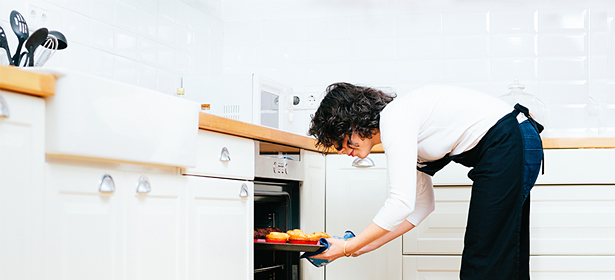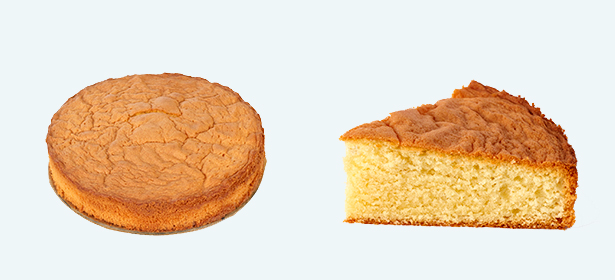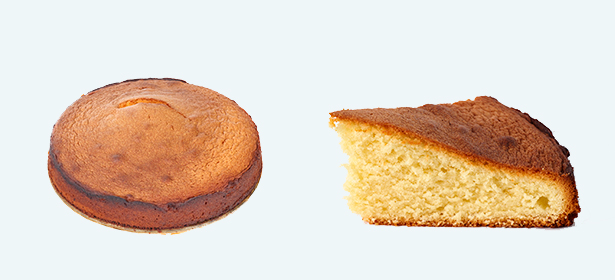
Get the Which? App
The Which? App puts Best Buys in your pocket – browse expert reviews from your phone and enjoy full access to Which? magazine
Find out more
Cooking food at the correct temperature is a small detail that can have a big impact on how it looks and tastes.
Our guide to oven temperature conversion, plus tips on how temperature affects your cooking, will help you get it spot-on every time.
Head to our expert pick of the best built-in ovens to discover ovens that maintain an accurate and stable temperature. Or to compare all lab-tested models, read our built-in oven reviews.
This simple oven temperature conversion chart should help you quickly convert temperatures between gas, Celsius, Fahrenheit and fan ovens.
| Gas mark | Fahrenheit (°F) | Celsius (°C) | Fan (°C) | Description |
|---|---|---|---|---|
| 1 | 275 | 140 | 120 | Cool |
| 2 | 300 | 150 | 130 | Cool |
| 3 | 325 | 160 | 140 | Moderate |
| 4 | 350 | 180 | 160 | Moderate |
| 5 | 375 | 190 | 170 | Moderately hot |
| 6 | 400 | 200 | 180 | Moderately hot |
| 7 | 425 | 220 | 200 | Hot |

The Which? App puts Best Buys in your pocket – browse expert reviews from your phone and enjoy full access to Which? magazine
Find out moreThe gas mark is a temperature scale used on gas cookers and gas ovens in the UK, Ireland and some Commonwealth countries.
If you own a gas cooker or gas oven, you will sometimes need to convert oven temperatures when cooking a recipe, which is when our oven temperature conversion chart will come in handy.
Using our chart, you can quickly see that 180°C is gas mark 4 and 200°C is gas mark 6.
Ovens often have all sorts of hi-tech features including steam cooking and self-cleaning, and some can even be controlled remotely by an app on your phone. But, unfortunately, this doesn't mean they get the basics right. We sometimes come across ovens that soar to 220°C when set at 180°C.
While it's more common for an oven to overshoot the temperature you set it at, we do also find models that struggle to get up to the right temperature. One of the ovens we've recently tested was set for 180°C, but we measured the temperature in part of the oven to be just 150°C.
All ovens have built-in thermometers. The best way to verify the accuracy of your oven's temperature is to check it with a separate stainless steel oven thermometer.
You can position the thermometer in different areas of your oven to test the temperature and find hot or cold spots. Just make sure you leave the thermometer in each area for at least 10 minutes before checking for changes.
You can adapt to an oven if it averages just a handful of degrees away from the correct temperature, by turning it up or down a little. But if it's a larger gap – or the temperature fluctuates a lot during cooking – you could be in for some disappointing results.
Fan oven cooking temperatures are typically around 20°C less than conventional ovens. This is because the fan circulates hot air around the inside of the oven and into the food, ensuring a more even temperature and food that's cooked more quickly.
It's always worth double-checking your recipe, as not adjusting the temperature to account for this effect can cause the outside of your food to cook too quickly and spoil your dish.
As most ovens are fan assisted these days, you can usually assume that a recipe that only suggests one oven temperature is referring to fan ovens. Some will offer two, though – a hotter temperature for traditional ovens and a cooler one for fans.
There are many variables that can potentially affect the outcome of your bakes, from the ingredients you use to the temperature and humidity of your kitchen. Some things you can't control, but using an oven that accurately maintains the right temperature is a great starting point.
Here are a few tips to stack the odds in your favour for results worthy of The Great British Bake Off.
Don’t open the oven door This can spell disaster for sensitive dishes, such as soufflés, and delicate sponges don’t appreciate it, either. Our reviews highlight which ovens have great visibility through the door, so you can keep an eye on your bakes without compromising their rise.
Don’t overfill the oven While some ovens are better than others at spreading heat evenly and supplying your food with enough heat, this is a greater challenge if the oven is overloaded. Generally speaking, cooking on any more than two levels risks poorer results.
Measure ingredients carefully While it can be tempting to guess quantities if you're in a hurry, this is risky. The ratios for butter, sugar and flour are best stuck to so that you maximise your chances of good baking results.
Use foil to avoid overbrowning If you notice that your cakes or pastries are browning before they are cooked in the middle, loosely covering with foil may save the day. This lets the warm air circulate but protects the surface from more fierce direct heat.
Ensure your oven's temperature is accurate At the right temperature your cake mix should turn into a light, airy sponge that’s evenly risen, cooked through and gently browned on the surface. An oven that's too hot will cause moisture to evaporate too rapidly from the cake’s surface, resulting in an overbrowned cake that may be burnt on the edges before the insides are cooked through. The overheating also affects the structure; you’ll get drier, harder sponge around the sides than in the middle. Cooking at too low a temperature slows down the reactions, so each stage takes longer. And although you don’t risk burning the outside, the structure of the cake can be adversely affected. The rise is less, so you end up with a denser, less airy sponge.
Do you blame yourself when your sponge cake fails to rise or you burn your biscuits? It might not be you.
We've tested hundreds of ovens and found that many don't stick to the temperature you set them at. Some have even veered more than 40°C above the set temperature.
To test how much difference an oven with poor temperature controls can make to your cooking, we ran a test in which we baked a classic Victoria sponge. Using exactly the same recipe, we baked four cakes at different temperatures, ranging from 20°C under the recommended temperature to 40°C too hot.

As our results show, even a 20°C difference can have a marked effect on the appearance and texture of a cake. And the same applies to other dishes – if your oven runs too hot or too cold, you may find your dinner isn't ready when you expected or that it's burnt and bubbled over before the timer goes off.

The cake was too light in colour, sunken in the centre and not completely baked in the middle. The structure was very compact, as few air bubbles developed during the baking process.

The cake had a good pale to mid-brown colour. After cooling it was fairly flat and had a good soft structure throughout. There were some small air bubbles and few medium-sized ones. A few cracks appeared on the surface towards the end of the baking process.

This cake turned out slightly too dark and, after cooling, was higher in the middle than at edges. There were surface cracks at the centre from where the cake has risen then sunk back down during cooling. The structure of this cake wasn't too bad – it was soft in the centre, but slightly harder near the base.

The surface colour was too dark and the cake was burnt around the edges. Its rise was uneven – much greater in the centre – and there were lots of surface cracks. The middle of the cake was soft textured, but the base and edges were much harder.
Note: We used a fan oven where the recommended temperature for the Victoria sponge recipe was 160°C.
Read our built-in oven reviews to find an model that maintains a stable temperature.